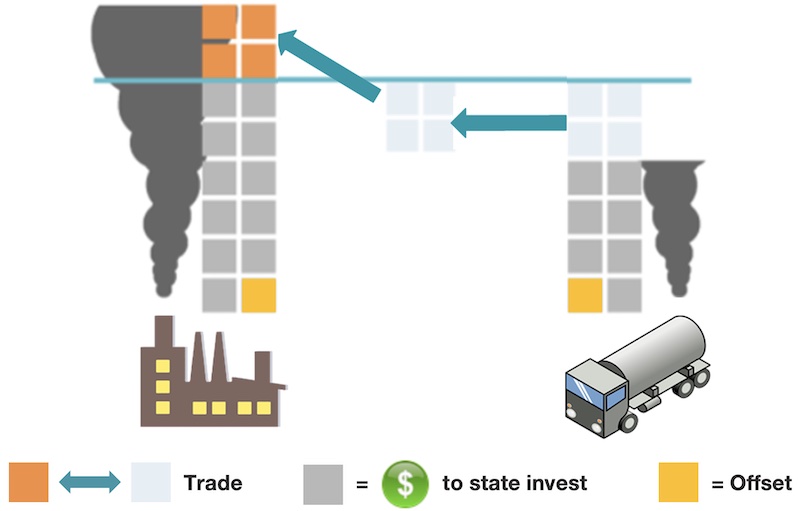Cap & Invest
How it works
A proven Cap & Invest model
Cap & Invest is the most efficient way to cut emissions and support the economy at the same time. The Climate Commitment Act is based on a successful model that is already working for other states, regions and nations. Their experiences helped us design the CCA to be successful. Let’s take a closer look at how it works.
The Cap
A limit, or cap, on carbon emissions is set that went into effect in January, 2023. The CCA’s cap covers about 100 entities, currently accounting for around 75 percent of statewide emissions, through 2050. These entities include stationary emitters, like heat-intensive industries and large fuel consumers, as well as fuel suppliers.
The cap decreases over time to meet state emission goals, which are a 45 percent reduction by 2030 and net-zero by 2050. So businesses must either find new ways to emit less and save money, or buy carbon allowances from the state (more on that in the next section).



Auction
Auctions are the primary compliance mechanism of the CCA. If companies can’t meet the cap, they can buy additional permits from the state, exchange with others who have allowances to spare, or offset their emissions. Offsets, however, are only eligible for a small portion of allowances in the CCA and importantly, remain under the cap. Our goal is fewer emissions overall, not simply offsetting them.
The credit auctions have both a floor and ceiling price. The floor ensures predictable cash for investments. The ceiling insulates from price shocks – protecting businesses & jobs. CCA’s auction will raise billions of dollars through 2030 and beyond.

Investments
This auction revenue is invested in climate priorities, like clean air, electrified transportation, energy efficiency and wildfire prevention — all with an emphasis on local jobs. Money earned by setting the cap is invested in projects that also lower emissions. So, two forces push down emissions simultaneously.
To formalize spending priorities, the CCA sets up an Environmental Justice & Equity Advisory Panel. This panel provides investment assessments and recommendations, centering the needs of overburdened communities.

Waste & Emissions Reductions
In addition to stimulating the economy, these investments also result in lower emissions, lower operating costs and help tackle priorities like reduced congestion, cleaner air and other public health benefits.
Our streamlined, low-waste economy will make our companies more competitive nationally and globally. By engaging the broad economy, we also broaden the opportunity for innovation. Even exempt sectors can join in the emission reduction cycle.
It’s not just a one-time win. The CCA builds a better system that can cut our state’s emissions by at least 20 million metric tons in the next decade. That’s like taking every car in our state off the road.
Climate Commitment Act
History
The Climate Commitment Act stands as a remarkable example of effective state-level policy aimed at mitigating climate pollution and fostering a fair and sustainable future.
Back in 2021, Washington state took a pioneering step by passing the Climate Commitment Act (CCA), a groundbreaking cap-and-invest legislation. This forward-looking law places a gradual limit on climate-warming emissions and allocates resources to implement solutions that promote equity, prosperity, and resilience across the state. Working hand-in-hand with other robust state policies, the CCA is projected to achieve an impressive 95% reduction in emissions by 2050. Moreover, it fosters stronger consultations with tribal nations, enhances air quality and environmental justice, bolsters climate-focused initiatives, and bolsters the state’s economy.
The journey toward passing the CCA holds valuable insights that can be adapted by other states seeking to address climate change. Prior to this achievement, numerous attempts to implement carbon pricing had faltered over the course of more than a decade. However, the CCA triumphed with the collective backing of a diverse coalition of stakeholders, representing a broad spectrum of interests within the state. This inclusive collaboration ensured that the law not only met science-based emission reduction targets but also brought about positive co-benefits for Washington’s environment, businesses, and marginalized communities.
Bipartisan Roots & State Leadership
Cap-and-Trade was first deployed by the George H. W. Bush administration to successfully – and efficiently – combat acid rain.

Charles Tasnadi / AP Images
Could it work as well on the climate crisis?
California was the first state to put Cap-and-Invest (an improved Cap-and-Trade) to work on greenhouse gas (GHG) reduction. Results there show targets achieved ahead of schedule, with a healthy economy.
Now, just as we in Washington state followed California’s lead but improved upon their program, we anticipate other states will follow our lead. Already, the state of New York is beginning the process of implementing a similar Cap-and-Invest system. California is considering improvements to their system by referencing Washington’s CCA.
Honored to stand w/ @JerryBrownGov he signs extension of cap & trade where we launched the program 11 years ago - a great bipartisan bill. pic.twitter.com/Xf91TbZXjX
— Arnold (@Schwarzenegger) July 25, 2017
Washington Adopts Cap & Invest
For a comprehensive overview of how the Climate Commitment Act became law, we highly recommend this piece from the National Caucus of Environmental Legislators.


